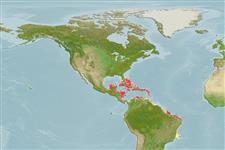>
Blenniiformes (Blennies) >
Chaenopsidae (Pike-, tube- and flagblennies)
Etymology: Stathmonotus: Greek, stathmos, -ou = a big room + Greek, noton = back (Ref. 45335).
Eponymy: Augustin Stahl (1842–1917) was a physician and naturalist in Puerto Rico, who made collections of local natural history specimens. [...] (Ref. 128868), visit book page.
More on authors: Evermann & Marsh.
Environment: milieu / climate zone / depth range / distribution range
Ekologi
marina revassocierade; djupintervall ? - 10 m (Ref. 13628). Subtropical
Eastern Caribbean Sea from Los Roques Venezuela, Lesser Antilles to Puerto Rico.
Size / Vikt / Age
Maturity: Lm ? range ? - ? cm
Max length : 4.0 cm TL hane/ej könsbestämd; (Ref. 7251)
Taggstrålar i ryggfenan (totalt) : 0; Mjukstrålar i ryggfenan (totalt) : 43 - 44; Taggstrålar i analfenan: 2; Mjukstrålar i analfenan: 24 - 25. Stathmonotus stahli differs from Stathmonotus tekla in the following: segmented caudal rays 11-13, modally 12 (vs. 10-12, modally 11); dorsal-fin spines 41-45, modally 43 (vs. 39-44, modally 42); and precaudal vertebrae 17-19, modally 18 (vs. 16-19, modally 17) (Ref. 82814).
Lives in rubble areas covered by mats of algae and sponges or in beds of finger coral. Generally found in less than 10 m depth (Ref. 13628).
Life cycle and mating behavior
Könsmognad | Reproduktion | Lek | Ägg | Fecundity | Larver
Robins, C.R. and G.C. Ray, 1986. A field guide to Atlantic coast fishes of North America. Houghton Mifflin Company, Boston, U.S.A. 354 p. (Ref. 7251)
IUCN Red List Status (Ref. 130435: Version 2024-2)
Threat to humans
Harmless
Human uses
Verktyg
Special reports
Download XML
Internet-källor
Estimates based on models
Preferred temperature (Ref.
123201): 26.4 - 28.2, mean 27.5 °C (based on 548 cells).
Phylogenetic diversity index (Ref.
82804): PD
50 = 0.5078 [Uniqueness, from 0.5 = low to 2.0 = high].
Bayesian length-weight: a=0.00525 (0.00219 - 0.01260), b=3.06 (2.85 - 3.27), in cm total length, based on LWR estimates for this (Sub)family-body shape (Ref.
93245).
Trofisk nivå (Ref.
69278): 3.3 ±0.5 se; based on size and trophs of closest relatives
Fishing Vulnerability (Ref.
59153): Low vulnerability (10 of 100).
Nutrients (Ref.
124155): Calcium = 146 [51, 344] mg/100g; Iron = 0.956 [0.470, 2.009] mg/100g; Protein = 18.6 [17.3, 19.8] %; Omega3 = 0.156 [0.068, 0.346] g/100g; Selenium = 6.89 [2.44, 19.97] μg/100g; VitaminA = 284 [76, 1,156] μg/100g; Zinc = 1.69 [0.94, 2.90] mg/100g (wet weight);
